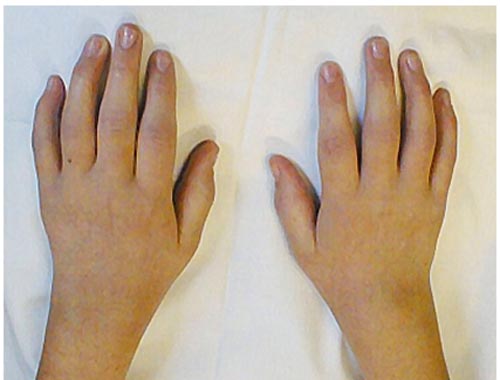Juvenile Rheumatoid Arthritis; JRA; Juvenile Idiopathic Arthritis; JIA; Juvenile chronic arthritis; JCA

Published: 18 Jun 2025
ICD9: 714.30 ICD10: M08.00 ICD11: FA24.1
All those terms – Juvenile Rheumatoid Arthritis (JRA), Juvenile Idiopathic Arthritis (JIA), and Juvenile Chronic Arthritis (JCA) – are different names for the same condition: a type of arthritis that begins in childhood (before the age of 16).
Here's a breakdown:
![]() Juvenile Rheumatoid Arthritis (JRA): This was the original name for the condition.
Juvenile Rheumatoid Arthritis (JRA): This was the original name for the condition.
![]() Juvenile Idiopathic Arthritis (JIA): This is the currently preferred and most widely used term. The word "idiopathic" means "of unknown cause," which is the case with JIA. It reflects the fact that the underlying reasons why a child develops this type of arthritis are not fully understood.
Juvenile Idiopathic Arthritis (JIA): This is the currently preferred and most widely used term. The word "idiopathic" means "of unknown cause," which is the case with JIA. It reflects the fact that the underlying reasons why a child develops this type of arthritis are not fully understood.
![]() Juvenile Chronic Arthritis (JCA): This is another term that has been used historically and may still be encountered.
Juvenile Chronic Arthritis (JCA): This is another term that has been used historically and may still be encountered.
Key Points:
![]() Definition: JIA is a chronic (long-lasting) autoimmune disease that causes inflammation and stiffness in the joints.
Definition: JIA is a chronic (long-lasting) autoimmune disease that causes inflammation and stiffness in the joints.
![]() Diagnosis: It's diagnosed based on symptoms, physical examination, and sometimes blood tests and imaging studies. To be diagnosed, the arthritis needs to have been present for at least 6 weeks and begin before the age of 16.
Diagnosis: It's diagnosed based on symptoms, physical examination, and sometimes blood tests and imaging studies. To be diagnosed, the arthritis needs to have been present for at least 6 weeks and begin before the age of 16.
![]() Types: JIA is not a single disease but rather a group of different arthritic conditions, each with its own characteristics and prognosis. Common subtypes include:
Types: JIA is not a single disease but rather a group of different arthritic conditions, each with its own characteristics and prognosis. Common subtypes include:![]()

![]() Oligoarticular JIA: Affects four or fewer joints (most common type).
Oligoarticular JIA: Affects four or fewer joints (most common type).![]()

![]() Polyarticular JIA: Affects five or more joints.
Polyarticular JIA: Affects five or more joints.![]()

![]() Systemic JIA: Affects the whole body, causing fever, rash, and inflammation of internal organs in addition to arthritis.
Systemic JIA: Affects the whole body, causing fever, rash, and inflammation of internal organs in addition to arthritis.![]()

![]() Enthesitis-related arthritis: Involves inflammation where tendons and ligaments attach to bone (entheses).
Enthesitis-related arthritis: Involves inflammation where tendons and ligaments attach to bone (entheses).![]()

![]() Psoriatic arthritis: Associated with psoriasis (a skin condition).
Psoriatic arthritis: Associated with psoriasis (a skin condition).![]()

![]() Undifferentiated arthritis: Doesn't fit neatly into any of the other categories.
Undifferentiated arthritis: Doesn't fit neatly into any of the other categories.
![]() Symptoms: Common symptoms include joint pain, swelling, stiffness, warmth, and limited range of motion. Other symptoms can include fever, rash, eye inflammation (uveitis), and fatigue.
Symptoms: Common symptoms include joint pain, swelling, stiffness, warmth, and limited range of motion. Other symptoms can include fever, rash, eye inflammation (uveitis), and fatigue.
![]() Treatment: There is no cure for JIA, but treatment focuses on managing symptoms, reducing inflammation, preventing joint damage, and maintaining function. Treatment options may include:
Treatment: There is no cure for JIA, but treatment focuses on managing symptoms, reducing inflammation, preventing joint damage, and maintaining function. Treatment options may include:![]()

![]() Medications (NSAIDs, DMARDs, biologics, corticosteroids)
Medications (NSAIDs, DMARDs, biologics, corticosteroids)![]()

![]() Physical and occupational therapy
Physical and occupational therapy![]()

![]() Eye exams (to monitor for uveitis)
Eye exams (to monitor for uveitis)![]()

![]() Healthy lifestyle (exercise, diet)
Healthy lifestyle (exercise, diet)
![]() Prognosis: The outcome of JIA varies depending on the type and severity of the disease. Early diagnosis and treatment can improve the prognosis and help children live full and active lives.
Prognosis: The outcome of JIA varies depending on the type and severity of the disease. Early diagnosis and treatment can improve the prognosis and help children live full and active lives.
In summary, JRA, JIA, and JCA all refer to the same group of childhood arthritic conditions. JIA is the preferred term because it accurately reflects that the cause of the disease is unknown.